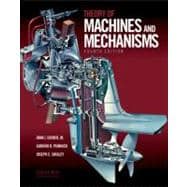Theory of Machines and Mechanisms provides a text for the complete study of displacements, velocities, accelerations, and static and dynamic forces required for the proper design of mechanical linkages, cams, and geared systems. The authors present the background, notation, and nomenclature essential for students to understand the various independent technical approaches that exist in the field of mechanisms, kinematics, and dynamics.
Now fully revised in its fourth edition, this text is ideal for senior undergraduate or graduate students in mechanical engineering who are taking a course in kinematics and/or machine dynamics.
New to the Fourth Edition
- Includes more worked examples throughout, and many new and updated end-of-chapter homework problems
- Coverage of helical gears, bevel gears, worms, and worm gears is now integrated into a single chapter
- Material on planar and spatial dynamic force analysis is now integrated into a single chapter
- A completely new chapter has been added on multi-degree-of-freedom planar linkage analysis
- The chapter on kinematic synthesis has been markedly expanded, and now includes three and four accuracy position graphical methods
- The chapter on static force analysis has been expanded to included coverage of buckling of axially-loaded two-force members under compression
Supplements
- In-text CD includes Working Model animations of many figures from the text to help students visualize and comprehend their movement
- A companion website for instructors (www.oup.com/us/uicker) provides additional information and resources, including PowerPoint-based slides of figures from the text








